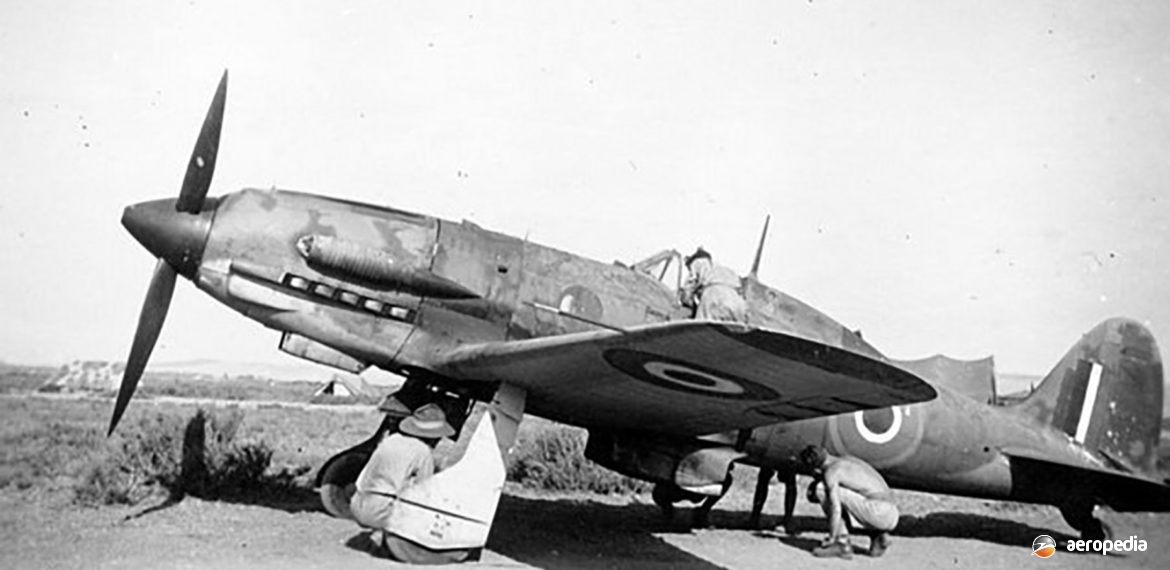Photograph:
A captured C.202 Folgore in North Africa, thought to be with No 3 Squadron RAAF (Author’s collection)
Country of origin:
Italy
Description:
Single-seat piston-engined fighter and fighter bomber
Power Plant:
One 877 kw (1,175 hp) Alfa Romeo RA.1000 R.C .41-I Monsoni 12-cylinder inverted-VEE liquid-cooled engine
Specifications:
- Wingspan: 10.60 m (34 ft 8½ in)
- Length: 8.83 m (29 ft 0½ in)
- Height: 3.04 m (9 ft 11½ in)
- Wing area: 16.799 m² (180.83 sq ft)
- Max speed at sea level: 497 km/h (309 mph)
- Max speed at 2,000 m (6,560 ft): 544 km/h (338 mph)
- Max speed at 4,000 m (13,120 ft): 586 km/h (364 mph)
- Max speed at 4,999 m(16,400 ft): 595 km/h (370 mph)
- Time to 1,000 m (3,280 ft): 39 seconds
- Time to 6,000 m (19,685 ft): 5 mins 55 secs
- Service ceiling: 11,500 m (37,730 ft)
- Normal range: 764 km (475 miles)
- Empty weight: 2,350 kg (5,181 lb)
- Normal loaded weight: 2,930 kg (6,459 lb)
- Max loaded weight: 3,010 kg (6,636 lb)
History:
The C.202 Folgore (Lightning) was first encountered by allied forces over Sicily in 1941 and was found to be the Regia Aeronautica’s (Italian Air Force) first fighter aircraft able to cope with allied fighter aircraft. It was reported to retain the beautiful control co-ordination and superlative maneuverability which had characterised its production predecessor, the C.200 Saetta. In 1940 a Daimler Benz DB 601 12-cylinder inverted VEE liquid-cooled engine was obtained from Germany and fitted to a C.200 fighter, in this form flying for the first time on 10 August 1940. Subsequently the DB 601 engine was placed in production by Alfa Romeo as the RA.1000 RC44 and the new type became known as the C.202 Folgore, entering service in 1942.
The type entered production in late 1940, initially with Breda under sub-contract, and it had two 7.69 mm (0.303 in) Breda-SAFAT machine guns in the wings and two 12.7 mm (0.5 in) machine guns installed above the engine. It was able to carry up to 160 kg (353 lb) of bombs or fuel tanks. A number of variants was built, one ‘Serie’ having two 20 mm Mauser MG 151/20 cannon in underwing fairings. Approximately 1,500 examples were completed, including 392 by Macchi. They soon achieved superiority over the Hawker Hurricane and Curtiss P-40 in operation with the allies for a period before new aircraft were supplied to allied squadrons.
Structure of the new fighter was similar to that of the Saetta, the vertical and horizontal tail surfaces, and the undercarriage being the same, the wings being almost the same except for the installation of fuel tanks in each of the inboard wing sections. However, the fuselage was of improved aerodynamic form and, despite the dislike of Italian fighter pilots to having an enclosed cockpit, this was installed. Initial production aircraft had DB 601A-1 engines fully imported from Germany until licence production took over, driving a Piaggio P.1001 constant speed propeller.
Early production aircraft were delivered to Italian forces in Libya in November 1941, the first unit being 1º Stormo Caccia Terrestre, and in the following May of 1942 4º Stormo arrived in the western desert. These units soon proved the performance of the new aircraft when opposed by the Hawker Hurricane and Curtiss P-40 series. However, Italian factories were unable to produce the DB 601 series engine in sufficient numbers, the maximum being only 50 units per month, so the production of the C.200 Saetta had to continue to meet Air Force requirements for fighter aircraft.
As noted for the C.205 Veltro series, one past-time of allied units in the western desert campaign was to locate and take possession of abandoned enemy aircraft when aerodromes were over run, and Nos 3 and 450 Squadrons RAAF were involved in this program. At least one C.202 Folgore was captured by No 450 Squadron and flown by its pilots. It was painted in different markings to show it was not an enemy aircraft but photographs of the aircraft do not show that it was painted with the Squadron’s unit code. Be that as it may, it would seem a number of C.202s were captured and flown by Australian, British and South African units at that time but none have survived.

